No results were found for the filter!

Carl Ditters von...
Concerto No. 2, Kr. 172 (E major) Contrabass (solo tuning) and piano
In the copy by Johannes Sperger, which must serve as the source today, the double bass is in D major, but the parts are in E flat major. In the meantime, D major has established itself as the key for the double bass part. Accordingly, the key was chosen for the tuning of the double bass used in each case. Dynamic and articulation indications are taken from the first edition by Franz Tischer-Zeitz (B. Schott's Söhne, Mainz 1938), but should only be understood as suggestions. The playalongs offered only contain the respective main parts of the solo: 1st movement T17 - T106 2nd movement T13 with upbeat - T53 3rd movement T29 with upbeat - ending Level of difficulty 3 : Fingerings may need to be entered and practised The edition is also available as a pdf file. Click on the drop-down menu under ‘Issue (please select)’
Mehr €12.00 *

Friedrich Seitz
Student Concerto No. 5, op. 22 Violin and piano
From practice for practice: ‘dumb it down’ is a series of simplified piano accompaniments by Philip Lehmann to standard works for various instruments, which also offer piano players without a degree the opportunity to accompany their pupils, children, friends etc. Level of difficulty 3 : Fingerings may need to be entered and practised The edition is also available as a pdf file. Click on the drop-down menu under ‘Issue (please select)’
Mehr €9.00 *

Anja Elsholz
Susi und Eddi - Bratschenschule für Kinder, Band 1 mit... Für Einzel- und Gruppenunterricht
Wer kennt nicht die lustigen Äffchen Susi und Eddi, die schon manche Schülerin und manchen Schüler durch den Violinunterricht bis hin zu den großen Konzertbühnen begleitet haben? Jetzt können die Jüngsten unter Anleitung der beiden Äffchen auch das Bratschenspiel in Angriff nehmen. "Susi und Eddi. Bratschenschule für Kinder ab 5 Jahren" von Anja Elsholz bietet dabei in Anlehnung an die bekannte Violinschule Spielspaß und ein einfaches Erlernen des neuen Instruments mit Hilfe bekannter Kinderlieder, mehrerer Fragespiele sowie kindgerechter Erklärungen zur richtigen Haltung oder auch dem Bau des Instruments. Die dem Heft beiliegende CD bietet den Kindern die Möglichkeit, sich die Lieder durch Hören einzuprägen und das bereits Gelernte noch einmal zu vertiefen. Inhalt: - Die Bratsche und ihre Teile - Die Namen der vier leeren Saiten - Kennst du schon ... Noten? - Die ersten Lieder - Noten-Linien-Bratschenschlüssel - Der Bogen und seine Teile - Bogenhaltung / Aufstrich und Abstrich - Verse zum Vorsprechen und Nachstreichen - Verse - Das Saitenwechsel-Lied - Der freche Wurm - Der Elefant - Hundelied - Die Eule - Geisterstunde - Piratenlied - Der Kuckuck und der Esel - Frage-Zeit 1 - Das Knusperhaus - Der Ein-Finger-Tanz - Vogelhochzeit - Forte- Piano - Feier im Hühnerstall - Hänsel und Gretel - Taschengeld - Frage-Zeit 2 - Wer kann das erraten? - Lieber guter Nikolaus - Der Zwei-Finger-Tanz - Chinesische Melodie - Schnurrli die Katze - Der Zauberer Mim - Schottisches Lied - Karl der Dackel - Vier kleine Übungsstücke - Susis Lieblingslied - Heute - Old Mac Donal had a Farm - Frage-Zeit 3 - Zehn kleine Zappelmänner - Backe, backe Kuchen - Der Jäger - Alle meine Entchen - Ist ein Mann in' Brunn' gefallen - Freut euch des Lebens - Das Schnabeltier - Dornröschen - Cowboylied - Die Dur-Tonleiter als Melodie - Klassisches Musikstück - Klug geübt? - Bruder Jakob - Fragezeit 4 - Hänschen klein - Der Vier-Finger-Tanz - Summ, summ, summ - Schlaf', Kindlein, schlaf' - Fuchs, du hast die Gans gestohlen - Drei kleine Übungsstücke - Alle Vögel sind schon da - Es tanzt ein Bi-Ba-Butzemann - Kroko-Kanon - Ein Männlein steht im Walde - Europa-Hymne - Abschlusszeugnis
Mehr €18.90 *
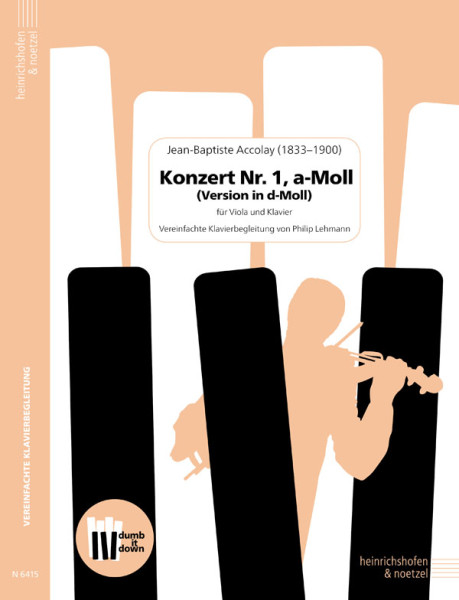
Jean-Baptiste Accolay
Concerto No. 1, A minor | Version in D minor Viola and piano
From practice for practice: ‘dumb it down’ is a series of simplified piano accompaniments to standard works for various instruments, which also offer piano players without a degree the opportunity to accompany their students, children, friends, etc. This concerto is one of the standard works that are necessarily learnt on the way into the world of violin literature. In order to make this popular performance work accessible to viola students, it has been transposed to D minor. Level of difficulty 3 : Fingerings may need to be entered and practised The edition is also available as a pdf file. Click on the drop-down menu under ‘Issue (please select)’
Mehr €11.50 *
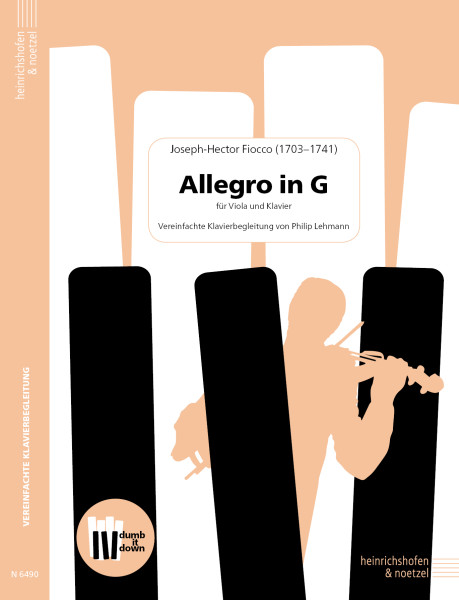
Joseph-Hector Fiocco
Allegro in G Viola und Klavier
From practice for practice: ‘dumb it down’ is a series of simplified piano accompaniments to standard works for various instruments, which also offer piano players without a degree the opportunity to accompany their students, children, friends, etc. The ‘Allegro in G’ was originally the tenth piece in the collection ‘Pièces de clavecin op. 1’ for harpsichord as ‘Allegro’. Level of difficulty 3 : Fingerings may need to be entered and practised The edition is also available as a pdf file. Click on the drop-down menu under ‘Issue (please select)’
Mehr €9.90 *
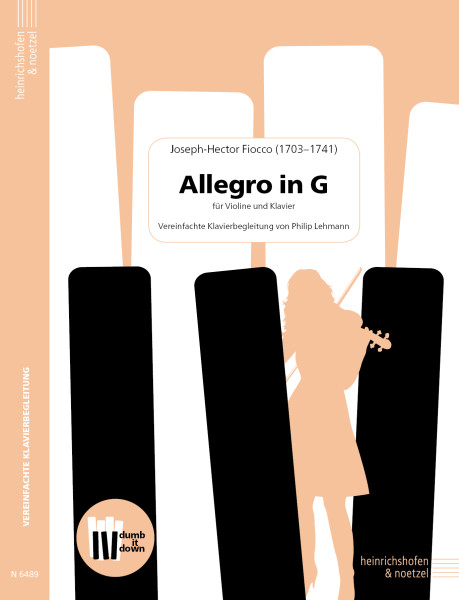
Joseph-Hector Fiocco
Allegro in G Violin and piano
From practice for practice: ‘dumb it down’ is a series of simplified piano accompaniments to standard works for various instruments, which also offer piano players without a degree the opportunity to accompany their students, children, friends, etc. The ‘Allegro in G’ was originally the tenth piece in the collection ‘Pièces de clavecin op. 1’ for harpsichord as ‘Allegro’. Schwierigkeitsgrad 3 : Fingersätze müssen ggf. eingetragen und geübt werden The edition is also available as a pdf file. Click on the drop-down menu under ‘Issue (please select)’
Mehr €9.90 *
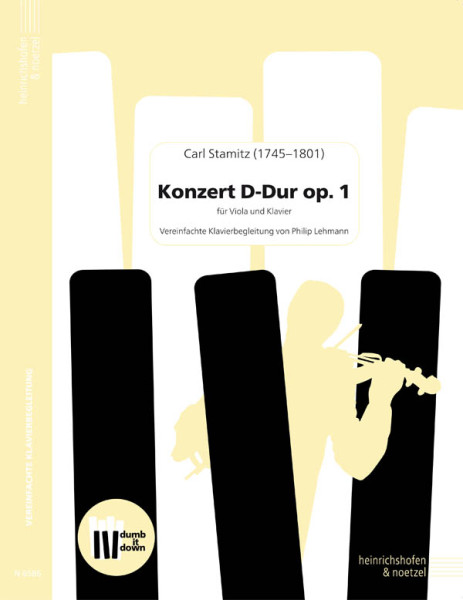
Carl Stamitz
Concert D-Major op.1 Viola and piano
The series ‘dumb it down’ offers simplified piano accompaniments to works for violin, viola, violoncello, flute, clarinet and other instruments. Level of difficulty 2: must be looked at before the lesson, practised before the concert The edition is also available as a pdf file. Click on the drop-down menu under ‘Issue (please select)’
Mehr €13.00 *
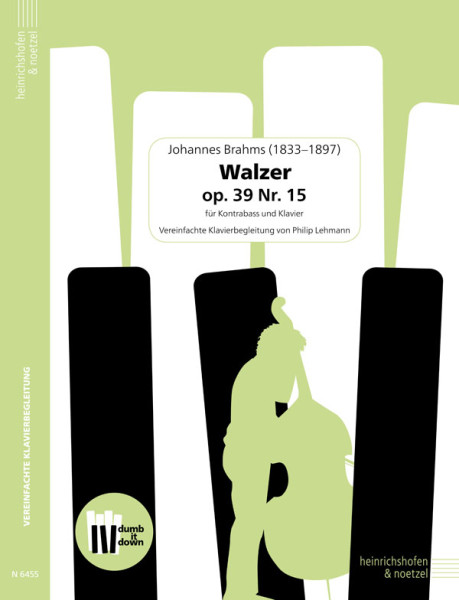
Johannes Brahms
Waltz op. 39 No. 15 Contrabass and piano
From practice for practice: ‘dumb it down’ is a series of simplified piano accompaniments to standard works for various instruments, which also offer piano players without a degree the opportunity to accompany their students, children, friends, etc. Brahms originally composed this waltz for piano four hands and later arranged it for piano two hands. In this case, therefore, there is no original piano setting for the accompaniment of a melody instrument. The ‘original’ piano setting used by Philip Lehmann as a model is a self-created essence of various sheet music editions available on the market. Difficulty level 1 : beginner, can be sight-read The edition is also available as a pdf file. Click on the drop-down menu under ‘Issue (please select)’
Mehr €9.00 *

Johann Sebastian Bach
Gavotte 1 and 2 from Orchestral Suite No. 3, BWV 1068 Violin and piano
From practice for practice: ‘dumb it down’ is a series of simplified piano accompaniments to standard works for various instruments, which also offer piano players without a degree the opportunity to accompany their pupils, children, friends etc. Level of difficulty 3* : Fingerings may need to be entered and practised * :For the most part it is sufficient to play the left hand (in lessons) The edition is also available as a pdf file. Click on the drop-down menu under ‘Issue (please select)’
Mehr Content 2
€9.00 *
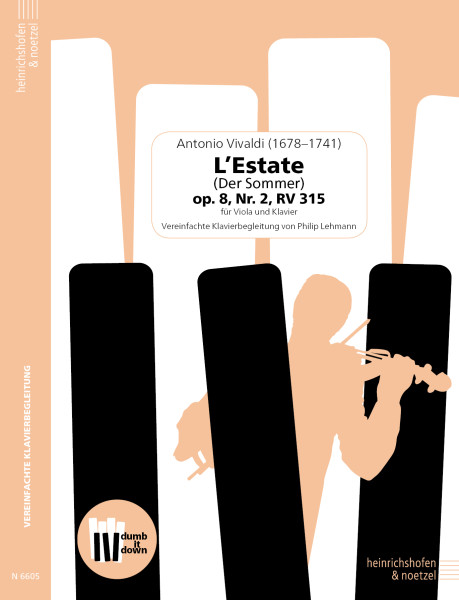
Antonio Vivaldi
L'Estate (The summer), op.8, No. 2, RV 315 Viola and piano
The ‘dumb it down’ series offers simplified piano accompaniments to works for violin, viola, violoncello, flute, clarinet and other instruments. The level of difficulty is strongly dependent on the tempo. The notation clearly differentiates which quavers should be played and which are optional by indicating the repetition marks (see the notation from bar 11 in the 3rd movement in particular). This additional possibility of simplification as well as a low tempo (realistic in a teaching context) justify the rating of the piano movement as 2. The faster the music is played, the closer you get to difficulty level 4. Level of difficulty 2: must be looked at before the lesson, practised before the concert Level of difficulty 3 : Fingerings may need to be entered and practised Level of difficulty 4 : Compared to the original, the piano writing has been greatly simplified, but can still be practised by amateurs The edition is also available as a pdf file. Click on the drop-down menu under ‘Issue (please select)’
Mehr €11.50 *

Niccolò Paganini
Moto perpetuo op. 11 Violoncello and piano
From practice for practice: ‘dumb it down’ is a series of simplified piano accompaniments to standard works for various instruments, which also offer piano players without a degree the opportunity to accompany their students, children, friends etc. Paganini wrote the ‘Moto Perpetuo’ like many other works for himself for violin and orchestra. The edition is also available as a pdf file. Click on the drop-down menu under ‘Issue (please select)’ Level of difficulty 2*: must be looked at before the lesson, practised before the concert * For the most part, it is sufficient to play the left hand (during lessons)
Mehr €10.50 *
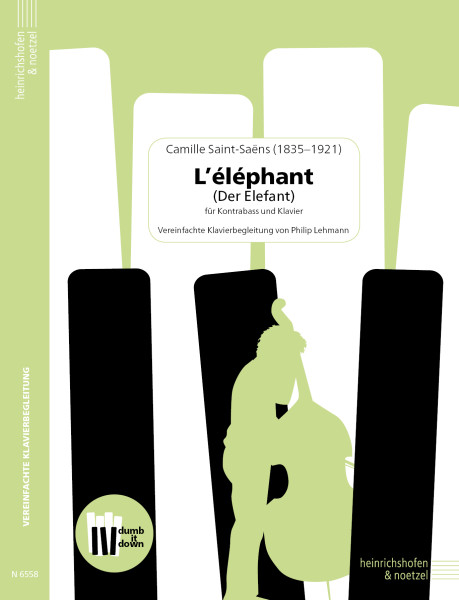
Camille Saint-Saëns
L'éléphant (Der Elefant) Contrabass and piano
From practice for practice: ‘dumb it down’ is a series of simplified piano accompaniments to standard works for various instruments, which also offer piano players without a degree the opportunity to accompany their students, children, friends etc. In order to be able to offer all possible performance options, this edition: - The piano part in the original key of E flat major, playable with the double bass part in E flat major for orchestral tuning or in D flat major for solo tuning. - The piano part in F major, playable with the double bass part in E flat major for solo tuning. Level of difficulty 1 : Beginner, can play at sight The edition is also available as a pdf file. Click on the drop-down menu under ‘Issue (please select)’
Mehr €9.00 *
Viewed
